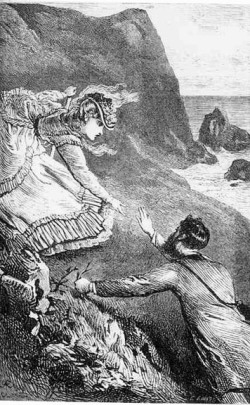
Hardy was one of the first authors to associate pre-Freudian concepts of strata of the mind with geological understanding of the earth and to employ this knowledge in his characterisation. Hardy understood that what lay beneath the surface was as important as the conscious mind, and his understanding of the geology of his homeland helped facilitate this. The Isle of Portland’s ‘infinitely stratified walls of oolite’ and ‘dazzlingly unique’ landscape afforded a perspective back through earth’s history, but also a lens inward on accumulated thoughts and feelings. As geological records offer deep insight into the earth’s illimitable past, the form of a novel or a poem can encompass emotional depths that ordinary language cannot convey. In Hardy’s fiction, sequences of events expose characters’ pasts and indicate the direction of their futures in a process of revelation that can at times be sudden and unpredictable. As fossil hunters on the Jurassic Coast a century before Hardy knew, accidental discovery could suddenly expand the parameters of geological knowledge and alter traditional perceptions. Hardy explored this idea in
A Pair of Blue Eyes, in which the protagonist - a geologist and ‘a solitary man of letters’ - ends up ‘spitted’ on Willapark Point in Cornwall, face to face with a Trilobite and ‘the varied scenes’ of the earth’s past, while contemplating the very real possibility of his own death.
In the late nineteenth century the emergence of subject disciplines encouraged greater distinctions between the arts and sciences. Hardy was one of the first fiction authors to seek to transcend such divisions and represent the interconnectedness of things. His perceived association between landscape and the mind developed after the death of his first wife in 1912, when he began to write only poetry. For the emotional poet, the coast promised to cleanse the mind of painful past events, yet also offered something more permanent and reassuring - expressed in The Well-Beloved in the pebbles of Chesil Beach that ‘remained undevoured’ against the ‘canine gnawing’ of the tides. The agents of geological change - the ‘tink-tink of the chisels in the quarries, the surging of the tides in the Bay, and the muffled grumbling of the currents in the never-pacified Race’ - form a backdrop to the novel and have significant implications for the lives of the people on the island. The ever-present sounds represent the earth’s grander state of flux, and are discernible in the fickle nature of the romantic protagonist, Jocelyn Pearston, the son of a quarry owner.
In Hardy’s time quarrying was a family tradition, an ancient practice that was part of the island itself. It is possible to imagine Hardy wandering Portland’s quarries, contemplating his next work of fiction, while watching, as he phrases it in The Well-Beloved: ‘horses in strings of eight or ten, painfully dragg[ing] down the hill the square blocks of stone on the antediluvian wooden wheels.’ The concept of retrieving material from the earth to make a living was not so far from the act of writing, as both required intimate knowledge of a particular terrain. Hardy, a worker of the imagination, perceived that as geological landscapes yielded surprising discoveries - petrified forests, the shells of fishes - so the human mind might be considered an equally unique territory of concealed emotions, experiences, and perceptions which come to light through the creative process of authorship. Through Hardy’s work runs a cleverly concealed subtext – an organic seam of thought - that encourages us to read between the ‘slaty layers’ and consider the earth’s history beside our own. Hardy’s creative insights reveal how geology and literature together can change the way we think – not just about the landscape but about ourselves.
- Thomas Hardy and the Jurassic Coast is a collaboration between the Hardy Society, Dorset-born artist and illustrator, David Brackston, and the Jurassic Coast Trust. Both educational charities seek ways for people to engage with geology and literature and together run a programme of Hardy walks in the Jurassic region. The booklet is available online through the Thomas Hardy Society and Amazon.